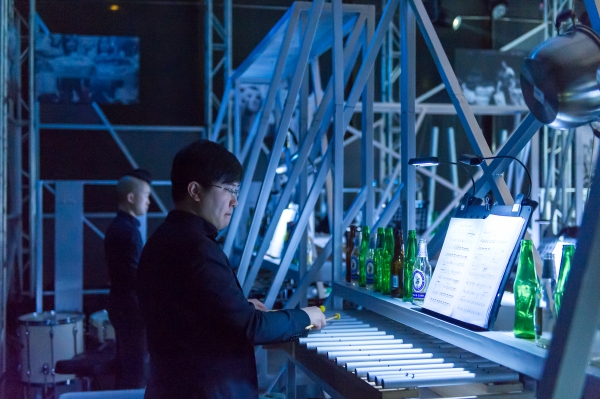
The Unexpected Heroine – How Alice Mong, Candace Chong, Eli Marshall & Chu Hei Chan Created ‘Mila’
By David SalazarAlice Mong, the Executive Director of the Asia Society Hong Kong Center never realized how much operatic talent there was in Hong Kong and Asia. That is, until she saw them work in a masterclass with soprano Renée Fleming in 2013.
Watching these artists work alongside the famed diva made Mong realize that Hong Kong and Asia was full of burgeoning opera talent that simply needed an outlet through which it could showcase its greatness internationally.
So when it came time to celebrate the fifth anniversary of the Asia Society Hong Kong Center in its new home at 9 Justice Drive, she knew exactly what she needed to do – she would commission a new chamber opera that would showcase these emerging talents.
But then she immediately ran into a challenge. Most commissions either come with a story built in, or a specific librettist or composer in mind. Mong had the latter.
She reached out to Candace Chong, who had recently written “Dr. Sun Yat-sen” for composer Huang Ruo, to go along with a number of award-winning plays including “Alive in the Mortuary,” “Shall We Go to Mars?,” and “Murder in San José.”
Chong had just finished working on “Dr. Sun Yat-sen” when she got the call from Mong.
“When Alice contacted me, she said she wanted a piece that reflects the muti-languages and culture, the diversity of Hong Kong,” Chong told OperaWire in a recent interview.
Composer Eli Marshall was also brought on to work on the opera and he collaborated with Chong on creating the story.
Initially, however, the two were not in sync as to the subject of the new opera.
“Candace and I discussed many, many topics and scenarios – a kind of ritual act of suggestion and countersuggestion that needs to happen in order to build something new together,” Marshall told OperaWire. “I wanted something from Hong Kong history. Candace preferred contemporary, and she convinced me in the end. She’s a master at teasing out the darkness and rich complexity in what many people would think of as everyday. Plus, having the challenge of a trilingual story was very compelling.”
“Mila,” as the opera would be named, would spotlight the life of a domestic worker.
“Mila” is Born
Chong was inspired by two different aspects of the story. The first was her own domestic worker Okah, who she first employed back in 2012 to take care of her three-year-old.
“She is a single mother and she also has a little boy in Indonesia,” Chong narrated. “I always feel guilty kissing my boy/getting close to my boy in front of Okah. As a mother, I can imagine how hard it is to leave your loved ones and work in a foreign country.”
She noted that journalist Mei Chi So had researched domestic workers from the Phillippines in Hong Kong and written about her findings in the book “Strangers at Home.” Reading the work inspired Chong all the more to move forward with the story for her new opera.
Moreover, taking on this story allowed the domestic workers to have a voice in an art form that usually ignores them.
“In opera we generally don’t hear from ‘the helper’ and we also don’t hear it sung in any Asian language that I know of,” Mong noted regarding the rare nature of the subject matter in opera.
“The helpers are considered as humble within the family,” Chong elaborated. “[They are] invisible to the society. They are underrated because of their occupation and their race. But I see the sacred in these women. And they should be sung with ‘high art.’”
But her desire to tell this story didn’t end there. Chong wanted to look at the domestic worker in the context of the modern family and the impact on the youth.
“Student suicide rate has been high in Hong Kong over the past few years,” she elaborated. “They often kill themselves mostly because the study pressure and family pressure.”
She noted that often the domestic workers are more in tune with the internal struggles of the children than their own parents are.
“That makes me angry,” Chong expressed, “that parents neglect their children’s feelings when they actually have the ‘privilege’ to know their kids better.”
Chong did note that the greatest challenge she struggled with in developing the story was in exploring the voice of a different culture.
“As a Hong Kong Chinese, I kept asking if I had the right, or the voice, to write about a Filipino,” she admitted. “I tried not to think about the political rightness, as I know I did it with good intentions. So I try to work out the script with the help of some natives, such as my domestic helper friends. I know the humanity in it is universal. But still, it’s a big challenge for me to pick up a role that shares a totally different culture with me.”
A New Soundscape
Chong was not the only one drawing from real-life inspiration in creating “Mila.”
Marshall noted that his first step in taking on the opera was eschewing what he called “pristine” sounds in favor of a sound world that could explore the rugged modernity portrayed in the libretto.
“I grow tired of instruments that sound too pristine, just as I do with bel canto singers who only worry about consistency of voice and forget to mine interest in the phonetic stuff of words,” he explained. “I believe in reclaiming a kind of roughness of sound material – in this case, quite literally, by building instruments from common building materials.”
Among the instruments that he created were the guitar box, microtonal chimes, large chimes made of aluminum conduit, and suspended pots and pans.
He noted that his idea for creating instruments came from his time in Mongkok where his apartment was on top of a building in an industrial sector. He noted that he used metals and other natural materials to build up his story and create emotional impact from very real elements.
“The end of the opera picks up the pieces of an increasingly fragmented story growing out of literally impossible pressures of life; representing suspension in water, we finally have a moment through the main character to savor long tones and just be in one place, for a moment, although it is also poignant,” noted Marshall.
This being an opera, casting the voices was of paramount importance to Marshall. The composer described this particular process as “scary,” given the limited time he had to find the right singers.
The character of Ma’am went to soprano Amanda Li, despite Marshall’s initially desire to write the role for a mezzo-soprano.
Joanne Shao was brought onboard due to her prominence in Hong Kong as well as due to the insistence of director Chu Hei Chan, who “supported her childlike countenance and ability to morph her robust soprano into a treble-like timbre.”
Joe Beutel came onboard at the recommendation of Catapult Opera Company Artistic Director Neal Goren. Finally, the title role of Mila went to Stephanie Quintin, who Marshall had first heard with the Hong Kong New Music Ensemble.
“I suspect in a few years it will be hard to pin her down – I’m sure she’ll be jetsetting between opera houses,” Marshall enthused.

Enter the Director
Director Chu Hei Chan was brought into the process early on as well. Marshall and Chong were familiar with his work as the Artistic Director of Theatre Horizon, and felt he was the perfect person to take on this unique opera experience. Chan surrounded himself with frequent collaborators in bringing his vision of the work to life, which focused on the lonely figures at the core of the opera.
“Apart from the issue of domestic helpers, this story shines a light on a typical middle-class family: where husband and wife do not communicate, nor do they talk to their children much,” he explained.
To express this fragmented family he turned to the work of Edward Hopper, which he believed to be among the most effective painters in depicting the loneliness of urban dwellers.
“My approach in this show isn’t about verisimilitude, but rather creating a performance that is abstract,” he explained. “Another part you will notice in the performance are objects that become highly symbolic: there’s the balcony in this family apartment (in a high-rise building), the dining table where lots of action take place, also the mobile phone, which has become an indispensable part of our lives today. But they are all symbols that accentuate the loneliness of urban dwellers too.”
He noted that the opera’s initial success after its 2018 world premiere hinged on the audience’s ability to relate to the central figure’s plight and connection with those around her. He hopes the same will happen for the performances in New York and San Francisco on Dec. 7 and 12, respectively.
“I want the audience to understand the plight of domestic helpers living in Hong Kong today. These helpers are working alone in the households they serve. They truly contribute to Hong Kong as a city, they really help the people living in Hong Kong,” Chan noted. His sentiments were echoed by the other collaborators.
“The audience will experience something original and unique but at the same time able to relate to the story of a modern dysfunctional family and the pressure of living in today’s Hong Kong,” Mong concluded. “I would like the audience to have empathy for the Boy and Mila and perhaps it will help to understand what is happening in contemporary Hong Kong.”
“It is a story about the way in which members of a family rely on Mila and struggle to survive even when she’s sacrificing more than they could imagine,” Marshall added. “For me, though I’m no Weill, this is a Brechtian story reminding us that we need to find a better way to do things in this world, whether in Hong Kong or not.”
“I hope they could share Mila’s pain and review some relationships in their own daily lives, knowing it is a privilege to be able to be kind to strangers,” Chong concluded. “When I say strangers, I also mean immigrants, refugees, and members of the less privileged population.”


